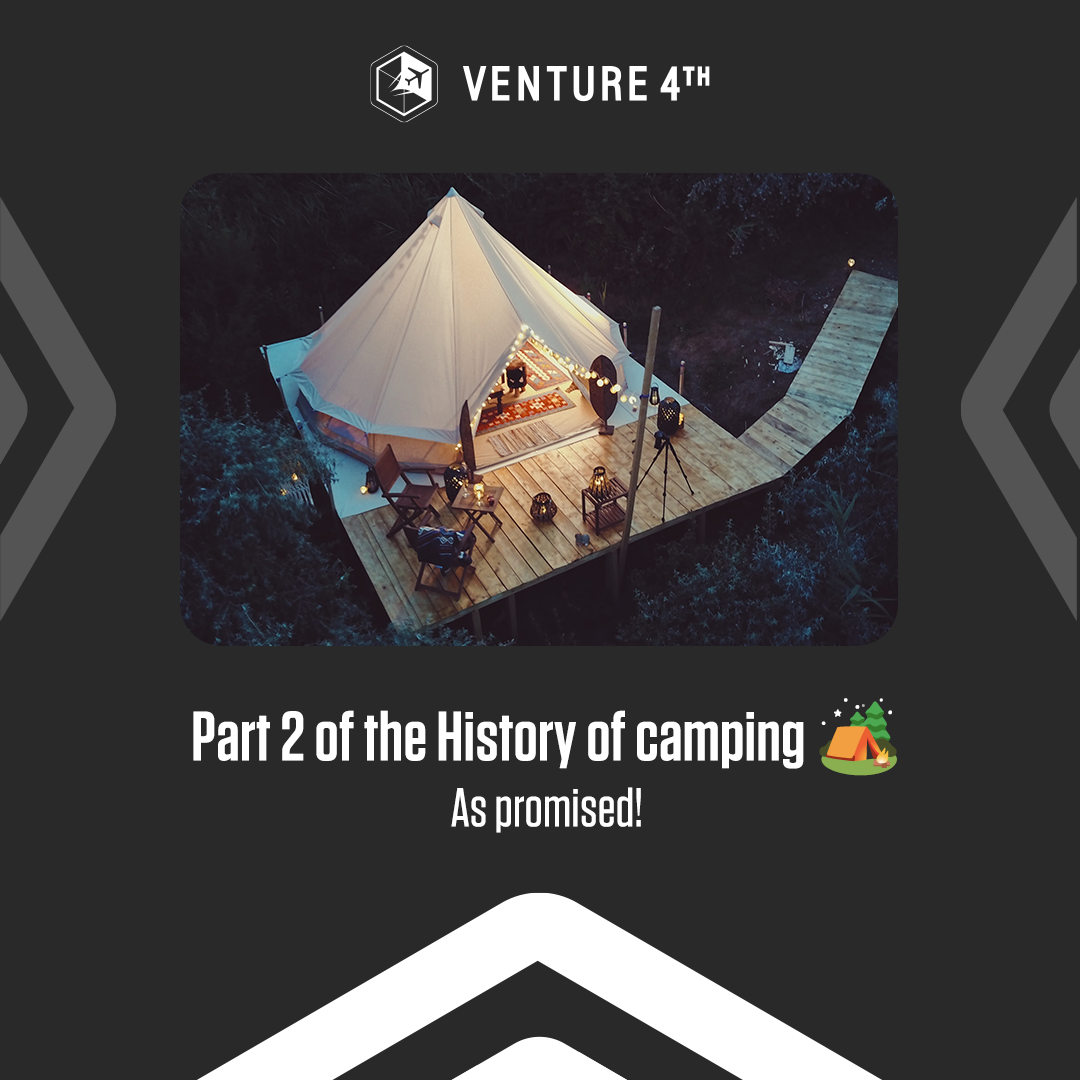We’re back with a part 2!
In the previous blog, we covered the history of camping from its origins and ancient civilization up until camping as recreation. Let’s continue our journey with…
Modern Camping Trends
The Rise of National Parks and Campgrounds
The establishment of national parks marked another watershed moment in the evolution of camping. These parks not only serve as preserved areas of natural beauty, but they also offer a designated space for people to interact with nature through recreational activities like camping. And in the United States, much of this can be attributed to President Teddy Roosevelt, a rugged outdoorsman who understood the importance of conserving natural landscapes for future generations.
Roosevelt’s advocacy led to the creation and expansion of numerous national parks, turning them into what many consider America’s “best idea” and creating a legacy that turned the U.S. into a camper’s paradise. Yellowstone National Park was the first of its kind, established in 1872, even before Roosevelt’s time. However, his influence accelerated the movement to establish more parks, creating a network of natural sanctuaries across the country.
The significance of national parks to camping cannot be overstated. By designating and protecting these natural landscapes, the government provided an accessible way for people to enjoy camping in some of the most spectacular settings imaginable.
RVs and Campervans: Home on Wheels
The concept of a ‘home on wheels’ isn’t new—nomadic peoples have utilized wheeled homes for centuries. However, it took the modern RV and campervan to bring this idea into the mainstream. Originating in the early 20th century, RVs and campervans were initially simple, makeshift vehicles used by passionate travelers and holidaymakers. As road infrastructure improved and the American love affair with the automobile grew, so did the capabilities and luxuries offered by these mobile homes.
RVs and campervans revolutionized camping by adding a layer of comfort and convenience that tents couldn’t match. They allowed campers to explore further and stay longer, extending the reach of where one could venture. Suddenly, you could take that cross-country trip and not worry about where you’d find the next suitable campsite. RVs and campervans brought along modern amenities—kitchens, beds, even bathrooms—that made the wilderness more accessible for families, seniors, and those who preferred a less “rugged” camping experience.
Looking for a way to make your camping more comfortable? Check out some of our premium sleeping bags.
The Impact of Technology on Camping
While some may argue that gadgets take away from the ‘authentic’ camping experience, the reality is that technology has made camping more accessible and safer than ever. Gone are the days when you’d solely rely on a map and compass; now we have GPS apps that work even in the most remote areas. Solar-powered chargers keep your devices powered, ensuring you can call for help or navigate back to your campsite. Advanced water filtration systems allow campers to make the most of natural water sources safely.
Moreover, there are now specialized apps that help you identify plants and animals, weather forecasting devices that can alert you to incoming storms, and high-efficiency portable stoves that make cooking easier and more sustainable. Technology has, in essence, lowered the barrier to entry for novice campers and added a layer of security and convenience for seasoned pros.
Glamping: Luxury Meets Wilderness
Glamping, a term coined by blending “glamorous” and “camping,” offers the best of both worlds. It allows you to immerse yourself in the great outdoors without sacrificing any of the comfort or luxury that you’d find in a high-end hotel.
Imagine this: sipping champagne or locally sourced organic tea under a chandelier, resting in a king-sized bed fitted with high-thread-count sheets, all while enveloped in a spacious canvas tent or even a climate-controlled dome.
No sleeping bags and inflatable mats; instead, you’ll find hardwood floors, plush rugs, and en-suite bathrooms with hot showers.
The Appeal of Glamping
So what draws people to this luxurious form of camping? For starters, it’s the ultimate compromise for mixed groups, like couples where one person loves the idea of roughing it and the other decidedly does not. Glamping appeals to those who relish the sensory experiences of nature—the sound of a river flowing or birds singing—but who also appreciate the creature comforts of a soft bed and a warm shower.
Moreover, in an age where social media plays a significant role in our lives, glamping offers highly Instagrammable moments. Everything from the tent itself to the meticulously curated interiors and the stunning natural backdrops makes for perfect photo ops. And let’s not ignore the food; many glamping experiences come with gourmet meals, often served under the stars, transforming camping into a luxurious culinary adventure.
Glamping Around the World
While the term “glamping” may have its roots in the English language, the concept is an international phenomenon, reflecting a universal love for comfort and nature.
In Mongolia, you’ll find yurts furnished with local textiles and wood-burning stoves. Down in Costa Rica, you can sleep in treehouses perched high above the rainforest floor. In Australia, eco-friendly glamping sites near the Great Barrier Reef offer snorkeling as a morning activity.
Each culture integrates its unique sensibilities and local materials into the glamping experience, creating a rich tapestry of luxurious outdoor living around the globe.
How Are People Reacting to It?
The rise of glamping has not been without its critics. Traditional camping purists often see it as antithetical to the spirit of camping, which for them is about simplicity and self-reliance.
However, it’s hard to argue with the growing popularity of glamping. It has opened up the joys of nature to those who might not otherwise consider themselves “outdoorsy,” and in a world increasingly disconnected from the natural world, that’s no small feat.
The Drawbacks of Glamping: Accessibility and Inclusivity
While glamping offers a unique and luxurious outdoor experience, it’s important to recognize its limitations, especially concerning accessibility. Glamping can be expensive, often prohibitively so for many would-be nature enthusiasts. The upscale amenities and curated experiences can push the costs to hotel-level prices, making it less of an option for those on a budget.
Furthermore, the very luxury that defines glamping can sometimes conflict with the principles of sustainability. Climate-controlled domes, gourmet meals, and other high-end amenities consume resources that could otherwise be minimized in traditional camping settings.
The Future of Camping
The increase in camping’s popularity, especially forms like glamping that can be resource-intensive, has some significant environmental ramifications. Every footstep in a national park, every campfire lit, every piece of trash not properly disposed of—it all adds up. From soil erosion to water pollution and wildlife disturbance, our love affair with nature could turn into a tragic story if we don’t act responsibly.
The “Leave No Trace” principle is more vital now than ever, encouraging campers to minimize their impact on the natural world. Some forward-thinking campgrounds are already implementing sustainable practices like solar-powered facilities, compostable waste systems, and educational programs that teach campers how to interact responsibly with nature. But it’s upon us, the camping community, to go that extra mile—be it by using biodegradable soap, packing out all our waste, or even participating in park clean-up programs.
The Role of Innovation in the Future of Camping
As we look toward the future, technology promises to further redefine the camping experience. Imagine drones delivering sustainably sourced firewood straight to your campsite or tents equipped with IoT sensors that assemble themselves. But as we embrace these innovations, it’s essential that we don’t lose sight of what makes camping truly special: a communion with nature. Technology should serve to enhance this relationship, not replace it.
Some innovations aim to make camping more sustainable. Solar-powered stoves and LED lanterns, energy-efficient coolers, and water purification systems that eliminate the need for single-use plastic bottles are just a few examples. These technologies not only make camping more convenient but also lessen our ecological footprint, aligning with a future where camping and conservation go hand in hand.
In Conclusion
Camping has come a long way from its humble origins, and it will continue to evolve, shaped by technological advancements and shifting social attitudes.
But as we look to the future, the core essence of camping should remain unchanged: it’s a way to forge a deep, respectful relationship with the natural world.
And whether you’re a traditional camper or a glamper, that’s a vision we can all pitch a tent under.




